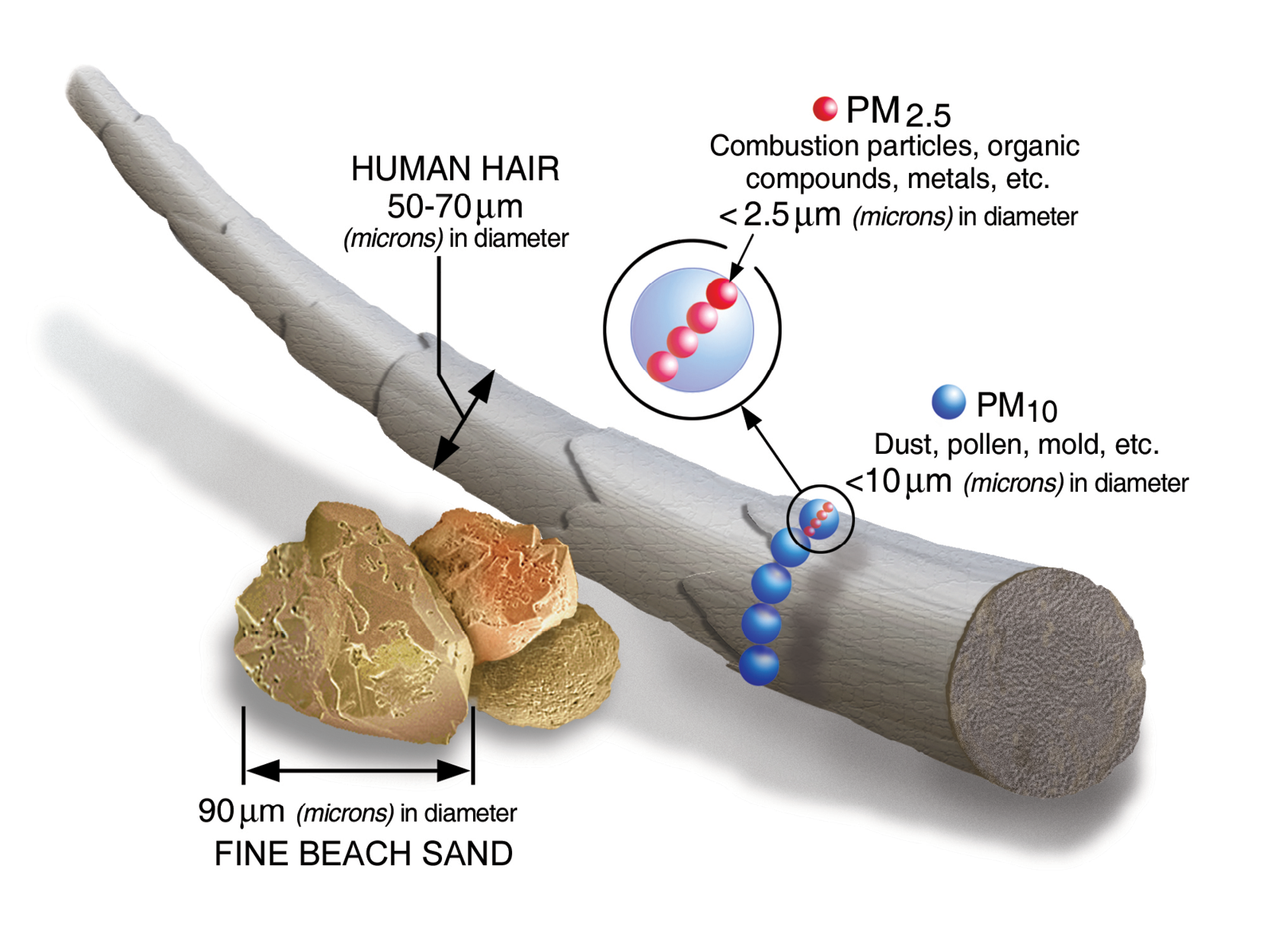Ultrafine Particles Overview: What are they and Where do they come from?

Ultrafine particles (UFPs) belong to a class of primary air pollutants called particulate matter (PM). Other types of PM include coarse particulate matter (PM10) and fine particulate matter (PM2.5). With a diameter of 0.1 micron or less, UFPs are the smallest known particles of PM. To put its relative size into perspective, UFPs measure 700 times smaller than the average diameter of a human hair.
The small size of UFPs and their vast numbers has led scientists to further investigate their properties and potential health impacts. Similar to other PM, UFPs can penetrate deep into the lungs; however, it’s unique ability to pass through the respiratory membrane, enter the bloodstream, and travel to the body’s organs (a process called translocation) poses further health concerns than its larger relatives.[1]
Where do UFPs come from?UFPs are a product of combustion processes emissions. Emission inventory studies have shown that road vehicles are the primary source of ambient UFPs.[1][3] These studies have been conducted in the following cities: California, USA; London, UK; Barcelona, Spain; Helsinki, Finland; and Zurich, Switzerland.[1][2][3] Researchers have determined that concentrations of UFPs tend to be highly variable even within the same city and appear to decline further from roadways.[1] Gas-to-particle conversions (nucleation) of anthropogenic sulfur dioxide and volatile organic compounds are also a significant source of UFPs.[2][3]
How are UFPs sampled and measured?The size of UFPs present challenges in terms of its detection and measurement. Relatively larger particulate matters, PM10 and PM2.5, are typically sampled using PTFE membrane filters through air sampling cyclones, and then measured in terms of mass concentration (µg/cm3). However, UFPs cannot be measured this way as their small size contributes negligible mass to an air sample. Currently, they are directly measured (without the need for sampling) using condensation particle counters and quantified as particle number concentration (particles/cm3).[1][2] Furthermore, additional parameters need to be controlled when measuring UFPs, including particle size cut-off, humidity, particle losses through diffusion, presence of semi-volatile particles, and general instrument sensitivity.[2] This makes the measurement of UFPs complicated, expensive, and difficult to quantify. Further research is needed to make measurement of UFPs cheaper and more reliable.[2]
Are there regulations set to control UFPs emissions?Currently, the World Health Organization (WHO) has only set air quality guidelines for PM10 and PM2.5. While epidemiologic studies suggest that UFPs may pose harmful effects to public health, the WHO and Health Effects Institute have concluded that the evidence was not enough to recommend regulatory standards for UFPs.[1] Continuous monitoring is needed to generate long-term data to support findings that correlate UFP with negative health effects.[2] This in turn will help to develop emission standards to reduce exposure to UFPs and mitigate potential public health impacts.
References
- Health Effects Institute. (2013). HEI Perspectives 3: Understanding the Health Effects of Ambient Ultrafine Particles. Retrieved from https://www.healtheffects.org/
- Air Quality Expert Group. (2018). Ultrafine Particles (UFP) in the UK. Retrieved from https://uk-air.defra.gov.uk/
- Rivas et al. (2020). Source apportionment of particle number size distribution in urban background and traffic stations in four European cities. Environmental International, 135, 105345 doi.: 10.1016/j.envint.2019.10534
Rivas et al. (2020). Source apportionment of particle number size distribution in urban background and traffic stations in four European cities. Environmental International, 135, 105345 https://www.epa.gov/pm-pollution/particulate-matter-pm-basics
- Most Viewed Blog Articles (5)
- Company News (284)
- Emerging Technologies (64)
- Microbiology and Life Science News (93)
- Water and Fluid Separation News (97)
- Filtration Resources (93)
- Product News (19)

![Join Sterlitech at BIO 2024 [Booth #5558]: Exploring the Future of Biotechnology](https://www.sterlitech.com/media/blog/cache/300x200/magefan_blog/b4.jpeg)




